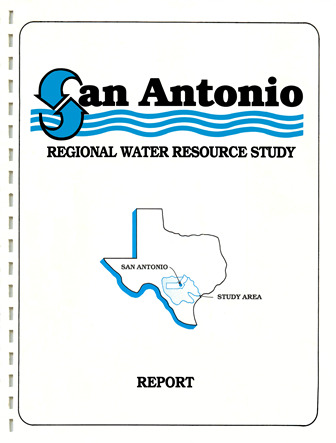San Antonio Regional Water Resource Study

| Author | CH2M Hill |
| Year | 1986 |
| Description | Analysis of regional water needs from 1980-2040. Note: This report is included for its historical value and may have been replaced by more recent studies. |
| Publisher | City of San Antonio and Edwards Underground Water District |
| Location | San Antonio Region |
| Cover | View Download |
| File | View Download |
| Summary |
|
Recognizing the need for long range water resource planning, the Edwards Underground Water District (EUWD) and the City of San Antonio jointly sponsored a comprehensive eighteen-month study of regional water resources and needs. The sponsors appointed a Technical Advisory Committee to oversee the study, which was conducted by CH2M HILL. This report summarizes the study findings. The study focuses on regional water needs from the base year of 1980 to the year 2040. The region is divided into a primary area including the counties that overlie the Edwards Aquifer (Uvalde, Medina, Bexar, Comal and Hays Counties) and a secondary area comprised of the remainder of the Nueces, San Antonio and Guadalupe River Basins. The major goal of the study is to develop three alternative courses of action for regional water resource management, with each representing a potential regional plan that includes provision for needed facilities (wells, pipelines and reservoirs), methods of financing, and the legal and institutional framework necessary for implementation. All alternatives are designed to:
The three alternatives to the status quo were established by first considering what options were available for environmental protection, water sources, financing, cost recovery and implementation within the framework of the goals set. Options in each of these areas were considered potential “building blocks” that could be used to construct alternatives. The hundreds of possible combinations of options were then screened to obtain reasonable combinations that represent likely possibilities for consideration.
The building-block elements of facilities, financing methods and legal/institutional provisions that make up each alternative could be modified or exchanged for similar building blocks from other alternatives. This provides the means for arriving at a consensus of regional opinion in seeking to adopt a plan and adds flexibility during the implementation phase. Existing information sources were used on water sources and demand projections. New work centered primarily on the combination of water sources that might be used and on the means for implementing a regional plan. The first three chapters of the study describe the goals, background, regional setting and approach of the study. Chapter 4 describes potential water sources and forecasts future demand. This is followed by development and analysis of water supply facility alternatives in Chapter 5. Chapter 6 contains recommended action plans and financing options for the three water supply alternatives. The body of the report is followed by 15 appendices in two separate volumes covering technical engineering, economic, legal and financial subjects. |
Search for Documents
Advance Search
Explore EAA's Scientific Reports
- All Reports
- History
- Groundwater Recharge, Recharge Zone
- Groundwater Movement
- Geomorphology and Caves
- Weather Modification
- Geology
- Water Use and Conservation
- Geochemistry
- Water Resources Planning and Management
- Floods and Drought
- Water Quality
- Climatology
- Surface Water / Groundwater Relationship
- Biology
- Springs, Groundwater Discharge
- Archaeology
- RZ Protection
- Aquifer Levels
- Remote Sensing
- Precipitation
- Overview Studies
- Modeling
- Hydrology and Hydrogeology
